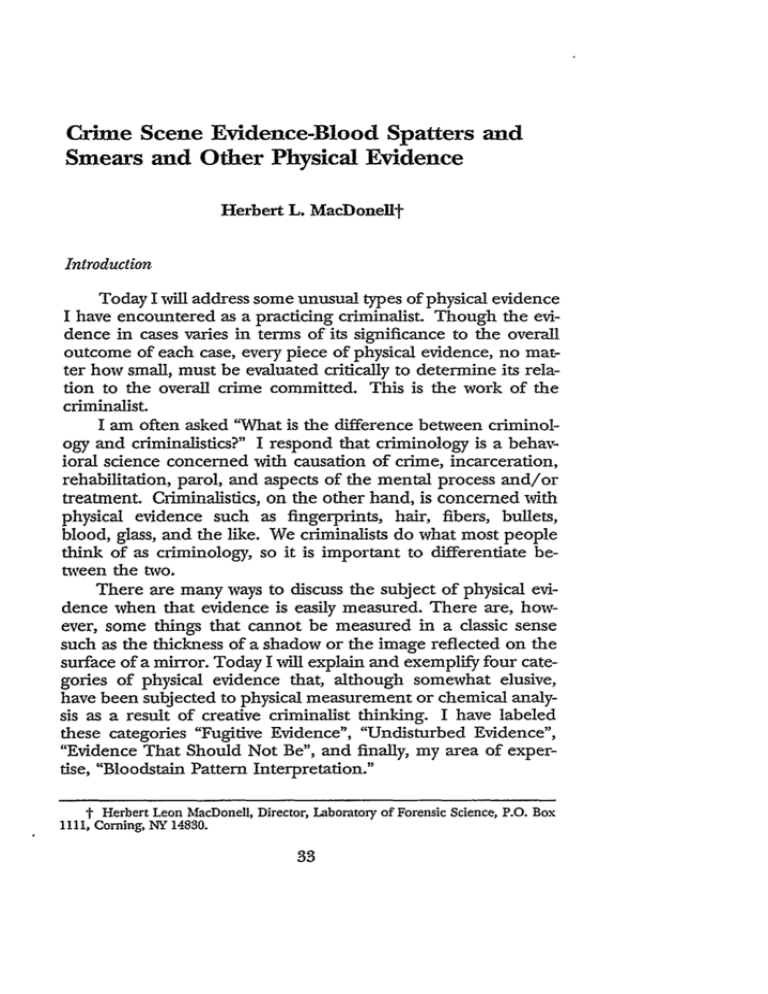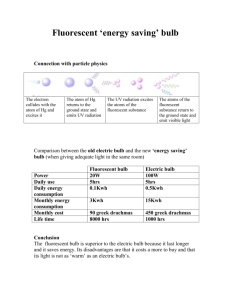Crime Scene Evidence-Blood Spatters and Smears and Other
advertisement

Crime Scene Evidence-Blood Spatters and Smears and Other Physical Evidence Herbert L. MacDoneilt Introduction Today I will address some unusual types of physical evidence I have encountered as a practicing criminalist. Though the evidence in cases varies in terms of its significance to the overall outcome of each case, every piece of physical evidence, no matter how small, must be evaluated critically to determine its relation to the overall crime committed. This is the work of the criminalist. I am often asked "What is the difference between criminology and criminalistics?" I respond that criminology is a behavioral science concerned with causation of crime, incarceration, rehabilitation, parol, and aspects of the mental process and/or treatment. Criminalistics, on the other hand, is concerned with physical evidence such as fingerprints, hair, fibers, bullets, blood, glass, and the like. We criminalists do what most people think of as criminology, so it is important to differentiate between the two. There are many ways to discuss the subject of physical evidence when that evidence is easily measured. There are, however, some things that cannot be measured in a classic sense such as the thickness of a shadow or the image reflected on the surface of a mirror. Today I will explain and exemplify four categories of physical evidence that, although somewhat elusive, have been subjected to physical measurement or chemical analysis as a result of creative criminalist thinking. I have labeled these categories "Fugitive Evidence", "Undisturbed Evidence", "Evidence That Should Not Be", and finally, my area of expertise, "Bloodstain Pattern Interpretation." t Herbert Leon MacDonell, Director, Laboratory of Forensic Science, P.O. Box 1111, Coming, NY 14880. QUINNIPIAC HEALTH LAW [Vol. 1:33 FugitiveEvidence Fugitive evidence is evidence that has disappeared because it was not noted or measured during the time in which it existed. It can be something as common as the temperature of a bottle of beer or a cup of coffee left on a table at a crime scene. If the temperature is not noted before it warms up or cools down to the ambient temperature, the significance of the temperature, if any, is lost. Similarly, the outline of a vehicle parked in a driveway before a rainstorm will be destroyed if the vehicle is moved before the rain stops, or if the sun dries out the overall wet area removing any evidence of the dry void pattern that was present in the driveway. UndisturbedEvidence Undisturbed evidence is evidence that is part of the crime scene because it is intrinsically part of the scene, not because the perpetrator left it at the scene (for example, a hair), created it at the scene (for example, ashes from a cigar) or disturbed something at the scene (for example, leaving fingerprints). The best way to discuss this type of evidence is to give you examples. Several years ago, in Horseheads, New York, I was asked to look at the physical evidence left after a man was crushed by the bulldozer he was driving. As he backed the bulldozer down into a ditch, its back end "bumped" very hard against the bank of the ditch. Both the driver and the driver's seat were thrown over the back of the bulldozer landing directly behind it. In the oil fields of Western New York where I grew up, we would have said that the driver went "ass-over-teakettle." The bulldozer was still in reverse gear. The bulldozer continued to back up and ran over the driver, who was crushed to death. My investigation of the driver's seat and the bulldozer provided an answer as to how this accident occurred. There was a one inch wide flange of metal, a continuation of the front of the driver's seat, which was simply bent forward at ninety degrees so it sat flat on the floor of the bulldozer. This flange ran all across the bottom of the front of the driver's seat and fit under the frame of the bulldozer. When the seat was forward, as it should be, it would not have been possible for the seat to slide backward and tip over. There were two holes in the bottom of the seat that 1996] CRIME SCENE EVIDENCE allowed three-eighths inch bolts to secure the seat to the frame. However, the inside surfaces of these two holes were completely encrusted with rust (undisturbed evidence) proving there had not been a bolt in either one of them for a period of time. The owner of the bulldozer was responsible for maintaining the safety features of the bulldozer. He could have been found guilty of criminally negligent homicide.' However, I think the case was settled out of court because no one ever contacted me to testify. In another interesting case, I was asked to examine a kitchen knife which was critical to a defendant's attempted murder case in Ithaca, New York.2 The prosecution tried to prove that the weapon, which it found, was the defendant's own kitchen knife. At trial, the defendant's wife testified that the knife she brought into court completed her set, making it impossible that the found knife was from their kitchen. The husband was found not guilty, in part because of his wife's testimony about the knife. Some time later the young wife was on trial for perjury.3 She was accused of introducing a new knife she bought during her husband's trial as one they had used in their kitchen for years. The wife testified that she had washed this knife twice daily for the past two years. In addition, the knife was covered with scratch marks, leading one to believe that it was old. My job was to determine if this knife was, in fact, old or new. I found a trace of adhesive on both of the brass rivets that went through the handle. This adhesive came from a special type of clear tape which is used to display items. Because the adhesive has the property of "balling up", like rubber cement, when it is washed with water, it can easily be removed. This type of tape was used to secure these "Granny's Butcher Knives"4 to a 1 N.Y. PENAL L ,w§ 125.10 (West 1996) ("Ciminallynegligent homicide- A person is guilty of criminally negligent homicide when, with criminal negligence, he causes the death of another person.") (Criminal negligence requires a determination that the conduct which caused injury or death involved a substantial and unjustifiable risk, and that the failure to perceive it constituted a gross deviation from the standard of care which a reasonable person would have observed under the same circumstances. People v. Haney, 284 N.E. 2d 564, 568 (1972)). 2 State v. Elder (citation unknown). 3 State v. Mastrollo (citation unknown). 4 "Granny's Butcher Knife" © Imperial Knife Company, Inc. QUINNIPIAC HEALTH LAW [Vol. 1:33 cardboard display backing. I purchased a similar knife and confirmed the composition of the adhesive which was used on the tape. Since the first washing would have removed the traces of adhesive, the wife lied about the age of the knife. The jury found her guilty of perjury.5 I would like to take some credit for my forensic chemistry, but I have to be fair. The District Attorney also had another witness, the salesgirl who sold the knife to the wife on the day she was to testify in her husband's trial. The salesgirl identified the accused, the knife, and the date of purchase! That is one advantage of living in a small town, everyone knows everyone else. Evidence That Should Not Be In some cases we find evidence that just does not make sense in light of our understanding of how things normally occur. For example, while I was working in the Rhode Island State Crime Laboratory with Dr. ("Doc") Harold C. Harrison, 6 a very interesting homicide case was brought to our attention. The case involved the rape and murder of Susan B. Franklin in Newport, Rhode Island on 24 April 1955.' Miss Franklin, an eightysix year old retired school teacher had lived alone since retiring. The most significant evidence in the case was a fingerprint left on a light bulb. "Doc" and I asked the police who had attended the crime scene why a light bulb was unscrewed when there was an electrical switch that could turn the light off. Did the perpetrator unscrew the bulb? If so, there would not be a usable fingerprint on the bulb, as the print would quickly "boil off' from the hot surface of the glass. When "Doc" Harrison brought the bulb back to the laboratory he gave it to me for processing. I dusted the bulb with black fingerprint powder and to my surprise I brought up a beautiful 5 State v. Mastrollo (citation unknown). 6 Dr. Harrison had a Ph.D. in chemistry from Cornell University. He was a Professor of Chemistry at the University of Rhode Island, and the Assistant Director at the University of Rhode Island State Criminal Investigation Laboratory, where he supervised scientific activities, and acted as a Special Assistant to the Attorney General, State of Rhode Island. 7 State v. Andrews, 134 A.2d 425 (1957). 19961 CRIME SCENE EVIDENCE fingerprint near its screw base. Careful examination of the fingerprint disclosed that the print was a tone reversal." How could such a reversal occur? Really, it was quite simple. The bulb was located at the top of a stairway above the kitchen. Many years of cooking had deposited a thin film of grease over the surface of the bulb. After the bulb was turned on it became hot and softened the grease on its base. Thus, when the perpetrator pressed his finger against the bulb he removed a portion of the grease. The grease removed by the friction ridges of the finger produced an outline of the valleys, which remained. When I dusted the bulb with fingerprint powder I actually developed a valley print rather than a ridge print. Therefore, I had to make a tone reversal 9 before a comparison to the suspect's inked fingerprint card could be made. I had no difficulty in making a positive identification of the processed latent fingerprint after I had made a tone reversal. There were twenty-five points of comparison between the evidence print and the known right thumb of the suspect, Edward J. Andrews. Although I dusted the bulb and made enlargements of it and Andrew's fingerprint card, Doc Harrison testified on the evidence. I agreed with this decision as he was better qualified to appear as an expert witness than I was at that time., As it turned out, the accused was convicted of the rape and murder of Susan B. Franklin. Another interesting aspect of the Susan B. Franklin case arose just prior to trial, while I was examining some of the exhibits I had prepared. One photograph I had prepared was an enlargement of the entire bulb. Most of my interest was on the greater enlargements that showed the area where I had developed the thumbprint. Looking at the entire bulb I suddenly realized that the base of the bulb would have to be facing down to have anyone unscrew it consistent with the placement of the 8 Tone reversal: the white portion of the pattern displayed the ridges of the finger rather than the %,alleys, or spaces between them. When a normal latent fingerprint is processed its ridges will hold the black fingerprint powder so the ridges are black and the valleys are white. 9 This was accomplished by photographing the processed fingerprint in the normal manner. In this instance, however, the resulting negativewas actually a positive. To correct this tone reversal, it was necessary to project the reversed negative on to another sheet of film. After it was developed, the result was a correct negative from which prints and enlargements could be made. 38 QUINNIPIAG HEALTH LAW [Vol. 1:33 thumbprint. How could this be if the bulb was a ceiling bulb? Assistant Attorney General Raymond A. Pettine from Providence was trying the case.' I asked Ray, who had been to the scene, "Was this bulb burning with the base up or the base down?" Ray thought for a moment and said, "Base down. You see, it was actually on a pedestal rather than on the ceiling." I was relieved by this answer because it meant the accused could have unscrewed the bulb from below in a normal manner. Had the bulb been burning with its base pointing up, it would have been very awkward for anyone to have unscrewed the bulb with their thumb pointing downward toward the floor. Bloodstain Pattern Interpretation I have been teaching and researching blood stain pattern interpretation for the past twenty-three years. When I first conducted research on the behavior of blood I studied how it dripped, spattered, cast-off, transferred, or was projected by some mechanism, such as arterial gushing.' At the time I had no anticipation that I would, in essence, open an entirely new forensic discipline, which is what I have apparently done. Since then I have educated eleven hundred students, some of whom have taught others. Unfortunately, some of these and still others who have never studied the subject at all, have made mistakes in analyzing blood transfer mechanisms, blood sequencing, expirated blood, and blood spatters, and in testifying in this discipline. The following stories and comments should shed some light on how these errors can be avoided. HistoricalBackground In 1955, when I first began experiments with human blood, and later in 1969, when I began my research for the Department of Justice, I found very little in the literature regarding bloodstain patterns. Today, however, I have located over five hundred and fifty such references. 2 10 Ray Pettine later was appointed Chief Federal Judge for the State of Rhode Island. 11 Arterial gushing produces characteristic bloodstain patterns on a surface as a result of blood exiting under pressure from a breached artery. 12 See selected bibliography at end of article. 19961 CRIME SCENE EVIDENCE The earliest reference describes a trial in London, in 1514, where bloodstains demonstrated that a death which was claimed to have been a suicide was, in fact, a homicide. 3 The victim, Richard Hunne, was incarcerated in Lollard's Tower to be examined on five charges of heresy. One morning Hunne was found hanged in his prison cell. After his demise, thirteen additional charges of heresy were brought against Hunne including one of Self-Murder [felo de se, suicide] . After a review of both the bloodstain and medical evidence, the ecclesiastical court found, "Whereby it appearth plainly to us all, that the Neck of Hunne was broken, and the great Plenty of Blood was shed before he was hang'd. Wherefore all we find by God and all our Consciences, that Richard Hunne was murder'd. Also we acquit the said Richard Hunne of his own Death."'15 Over the past several years, with the very capable assistance of my wife, Phyllis, who, fortunately for me is a librarian, I have found many outstanding books, journals, articles, and other printed material on patterns of human blood. The works of Piotrowski (1895),16 Gross (1898), i7 Balthazard (1939),18 and Walcher (1939), 19 deserve special recognition. Bloodstain pattern references have been published in English, German, French, Russian, Hungarian, Italian, Polish, Japanese, and Chinese. 0° No doubt there are others that we have not yet located. The search continues. After I published my report for the Department of Justice, Flight Characteristicsand Stain PatternsofHuman Blood2l, I received requests to set up a training program on this subject. The first Bloodstain Evidence Institute that I conducted was in Jackson, 13 Thomas Rogers Forbes, SURGEONS AT THE BAILEY - ENGLISH FORENSIC MEDICINE To 1878 (1985). 14 BLtCR's L.,W DICTIONARY 616 (6th ed. 1990). 15 Forbes, supra note 13, at 75-82. 16 E. Piotrowski, UBaR ENTS-EHuNG, FoRM, ICHTuNG UND AUSBREITUNG DEE BLUTSPUREN NACH HIEBWUNDEN DES KoPFEs (1895). 17 Hans Gross, INDBUCH FuR UNTERSUCHUNGSRICHTER, ALs S-vsrmm DER KMIMINAZIs-nr (1899). 18 V. Balthazard, Etude Des Gouttes De Sang Projete, ANN. MED. LEGALE CRIMINOL Er POUCE SCIENCE, MEDICINE SOCiALE ET TOXICOLOGY, V. 19 (1939). 19 Kurt Waicher, GERICHTLICHE MEDIZINISCHEUND KRIMINALrISCHE BLUTUNTERSUCHUNG (1939). 20 See selected bibliography at end of article. 21 MacDonell, Herbert L., Flight Characteristicsand Stain Patterns of Human Blood, Washington, U.S. Department ofJustice, L.EA.A, N.I.L.E.CJ. (1971). QUINNIPIAC HEALTH LAW [Vol. 1:33 Mississippi in March 1973. Since then, forty-three Institutes have been held, each five days in length, in Alabama, California, Colorado, Connecticut, Florida, Illinois, Indiana, Louisiana, Mississippi, New York, Pennsylvania, Texas, Washington D.C., Sydney, Australia, and Stockholm, Sweden.22 Problems in InterpretingBlood Transfer Mechanisms On 1 February 1994, I testified in the Quebec Court of Appeals on the mechanism by which the bloodstain pattern was produced on the accused's shirt. There was what appeared to be a medium velocity impact pattern23 of blood covering the front of the accused murderer's shirt. The accused admitted that he had been present in the apartment where an older man had been beaten to death with a fire extinguisher. The accused said he and his partner were burglarizing an apartment when the occupant surprised them. Although his accomplice was the one who beat the older man, there was an overall bloodstain pattern on the front of the accused's shirt which appeared consistent with his being near an impact source and having committed the murder. Closer examination of the shirt demonstrated that all of the bloodstains were the result of a transfer mechanism and not from projected blood. Simply stated, the bloodstains were on the tops of the shirt threads and not down between them. Projected blood will be found down between the threads, transferred blood will not. After his accomplice had beaten the older man, the accused went into the bedroom to look at the victim to be sure he was alright. He kneeled down beside the bed and leaned over the blood spatter pattern on the bed covers. The overall very small size of the bloodstains and the distribution of the spatter pattern on the bed covers was thereby transferred to the front of his shirt from the bed covers. 22 The most recent Institute on the PhysicalSknificance of Human Bloodstain Evidence was held 12-I6June 1995 in Solna (Stockholm), Sweden at the Swedish National Police College. 23 Medium velocity impact spatter is produced when an object, such as a baseball bat, strikes a bloody object, such as a victim's head, at a velocity of approximately twenty-five feet per second. High velocity impact spatter occurs when the velocity of the impact is at least one hundred feet per second. Usually, this refers to gunshot wounds. 1996] CRIME SCENE EVIDENCE Expirated or Spattered Blood Stains Sometimes, investigators have trouble distinguishing between blood that was spattered and blood that wasn't spattered. For example, a former student gave an opinion in a case that led to the arrest and trial of a man accused of shooting his wife in her bed. My student, who classified himself as a forensic reconstructionist,was hired by the Pennsylvania State Police to examine the bloodstains on a bedroom wall behind the victim's bed. The student's failure to thoroughly examine the bloodstains led to the mistaken arrest of the victim's husband. This forensic reconstructionist told the police that high velocity blood spatters on the wall allowed him to place the victim and the handgun in the proper relationship to each other. His scenario put the victim, and whoever might have shot her, in an awkward and almost impossible posture. Nevertheless, the prosecution accepted the report and relied heavily on it at trial. The defense attorney retained me to examine the same evidence, but I came to a completely different conclusion. I concluded that the victim committed suicide. All of the small bloodstains on the wall were the result of expirated blood, none were from impact spatter. Expirated blood results when blood is blown out from the mouth or nose. The act may be that of coughing or sneezing when blood is in these passages. It can also be produced if the face is in a pool of blood and an injured person continues to breathe, such as was the case here. The victim shot herself in the head while kneeling on the bed. After she fell over, her face made a slight depression in the surface of the bed, which gradually filled with blood. As she continued to exhale into the pool of blood she created a radiation pattern of blood on the wall behind her. It was this pattern that the police investigator used to identify the location of her head at the time she was shot. He was wrong. Careful examination of the small bloodstains on the wall clearly showed they all contained small air bubbles. Such bubbles will not be found in normal blood and are conclusive evidence of expirated or aspirated blood. It is unfortunate that the police relied on the advice of this investigator who led them to QUINNIPIAC HEALTH LAW [Vol. 1:33 arrest an innocent man. 2 4 Another rather complex case I worked on was reduced to basic simplicity when my examination of the defendant's shirt confirmed his participation in the beating death of a woman.2-5 His work shirt had pockets which had button down flaps at their tops. Blood from the victim's head spattered back all over the perpetrator's clothing. He had two hundred and fifty small bloodstains on his shirt and over three hundred more on his trousers. Both the top and the underside of his shirt pocket flaps were spattered. In addition, several small spots were on the top front of his shirt pocket in an area that would be covered by the flaps if they were down in their usual configuration. The only way the underside of the accused's flaps, or the area they cover when they are down, could have become bloodstained was if they were "flapping." That is, when the perpetrator raised and lowered his arm to inflict the beating, he also raised and lowered his shirt pocket flaps. The defendant was found guilty in four hours and given the death sentence. Sequence of Blood Stains It is frequently possible to establish the sequence of blood staining. For example, a few years ago, an attorney asked me to come to Florida to examine some physical evidence in a beating case. He advised me that his client had been accused of beating both his wife and mother-in-law. Both expired, although his wife lived long enough to be taken to a hospital where she regained consciousness. She told several people, "My husband did it!" The defense attorney asked me to examine the clothing of the young woman's brother. He was a male nurse and wore a white uniform. The attorney was sure that it was he, rather than his client, who killed the women. Although there were bloodstains present on this uniform, none could have been the result of impact spatter. The defendant and his brother-in-law both told a similar story. Both said that when they came to the scene and saw the two victims, they bent down and caressed the younger woman Commomvealth v. Roberts,Juniata County, Pennsylvania, Crim.No. 10 of 1993. State of Tennessee v. Melson, 638 S.W. 2d 342 (1982), cert. denied, 459 U.S. 1137 103 S.Ct. 770 (1983). 24 25 1996] CRIME SCENE EVIDENCE who, although unconscious at the time, was obviously still alive. That explained the transfer pattern of bloodstains on the white uniform. The clothing of the accused was never recovered so I could not examine it. After explaining the nature of the bloodstains on the nurse's white uniform to the defense attorney, I asked him about a bloodstained, cut-out section of sheetrock that was also in the same box as the clothing in the evidence room. He said, "That isn't important, we will stipulate that the bloody palmprint was made by the defendant when he stood up after caressing his wife on the floor." I showed him three distinct bloodstain patterns on the sheetrock and told him their sequence and significance. First, there were some very small spots of blood that were created as a result of the beating that occurred on the floor. They struck the wall in a typical dispersion manner.26 However, they were not normal bloodstains but only the skeletal outlines of their original form. It was obvious to me that shortly after the small droplets of blood struck the wall and partially dried around their periphery, their fluid centers were wiped away in some manner. Second, as the husband stood up, he placed his bloody left hand against the wall, presumably for support. He slid his wet left hand across the wall leaving a thin "swipe" pattern and then he pulled his hand away. This final contact left an identifiable palmprint. Third, there were some additional spots of blood that had been spattered on top of the swipe pattern. These spots had a normal appearance with solid centers. The long, very fine streaks that accompanied some of these bloodstains would have been broken up had they been on the wall prior to the bloody palm wiping across it. I noted that the origin of spatter of this third event was the same as the first, coming from directly below, near the floor. The defense attorney was totally unimpressed. He asked, 'WVhat does all of that have to do with my case?" I replied, 'Well, it puts your guy at the scene of the beating after it had started and before it was completed. He was there at the time it oc26 A dispersion pattern is somewhat like a narrow fan radiating out from the source of blood. 44 QUINNIPIAG HEALTH LAW [Vol. 1:33 curred, that's all." It did not take him very long to figure out that he did not want me in Florida any longer. I was on the next plane back to Corning. Too bad Brady v. Maryland only works on 27 a one way street. I learned later that the defendant was acquitted. The prosecution never figured out the sequence of the spatter/palmprint/ spatter evidence. Also, the defense had some witnesses who said they were with the accused at a distant location at the time of the crime. Finally, the victim's statements that her husband had beaten her were ruled inadmissable as hearsay because she did not believe that her death was imminent, one of the necessary ingredients of the dying declaration" exception to hearsay. Absence ofEvidence is not Evidence of Absence29 This tricky title describes an application of physical evidence that apparently has not been previously addressed in the forensic literature. Paul E. Kish and I wrote this article to address attorneys' unfounded belief that if their clients do not have blood on their clothing, they could not have committed the act. Unfortunately, we have to inform such attorneys that both from our experience, and from the literature, this is not the case. Explanations for the lack of bloodstaining on an individual who has actively participated in a violent act are innumerable. These include the assailant cleaning-up prior to his being apprehended, removal of his clothing prior to committing the act, or simply not being stained because spattered blood was intercepted by some intermediate target.Y0 Therefore, no one should speculate as to why a defendant was not bloodstained except in the most unusual cases. The lack of bloodstaining on the defendant should only be used as a reason for further 27 Brady v. State of Maryland, 378 U.S. 83 (1963) (holding that "suppression by the prosecution of evidence favorable to an accused upon request violates due process where evidence is material either to guilt or to punishment, irrespective ofgood faith or bad faith of prosecution.") Id. at 87. 28 FED R. EvD. 80(b) (2) ("In a prosecution for homicide or in a civil action or proceeding, a statement made by a declarant while believing that the declarant's death was imminent, concerning the cause or circumstances of what the declarant believed to be impending death.") Id. 29 Paul E. Kish & Herbert Leon MacDonell, Absence Of Evidence Is Not Evidence of Absence, 46Joua NA oF FoNisic IDENrIFICAMON 2, 160 (1996). 30 Id., at 160. 19961 CRIME SCENE EVIDENCE investigation. 3 ' Conclusion I have given several examples of unusual physical evidence. Unfortunately, while The Evidence Never Lies,-2 there are many investigations where the evidence is not understood through the incompetence .and/or ignorance of the examiner. Bloodstain pattern interpretation is not new. 3 Nevertheless, it has only recently come to the attention of the forensic community. Bloodstain pattern interpretation is not a panacea, but it certainly can be important in the reconstruction of prior events in many cases. Bloodstain pattern interpretation should always be considered by an attorney who is litigating a case that involves blood stains. 31 Id., at 162. 32 AuRED ALLAN LEIS with HERBERT LEoN MACDoNELt, THE EVIDENCE NEVER LIES (1984). SS Infra notes 12 - 18 and accompanying text.






